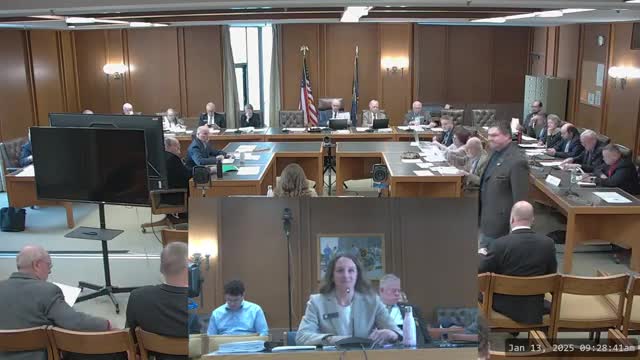Tax trends: meals & rentals, real estate transfer, tobacco and business taxes outline revenue pressure for FY25 — DRA
January 13, 2025 | Ways and Means, House of Representatives, Committees , Legislative, New Hampshire
This article was created by AI summarizing key points discussed. AI makes mistakes, so for full details and context, please refer to the video of the full meeting. Please report any errors so we can fix them. Report an error »

Lede: Lindsey Stepp, commissioner of the Department of Revenue Administration (DRA), briefed Ways and Means members on how major taxes performed through the first half of fiscal 2025 and on structural issues that will affect revenue estimation and the committee’s work.
Nut graf: Stepp walked the committee through the mechanics and recent trends for the meals & rentals tax, real estate transfer (RETT) tax, tobacco and e‑cigarette taxes, communication services tax, utility property tax, and the business enterprise and business profits taxes. Stepp stressed that business taxes are the largest and most volatile revenue source and that timing of filings and estimates complicates short‑term forecasting.
Body: On meals and rentals (M&R), the DRA noted continued growth since the pandemic but at a slowing rate: FY25 year‑to‑date M&R was up about 3.8% over the prior year. Stepp reviewed two regular transfers: school building aid debt service and the Municipal Revenue Fund transfer (30% of net M&R distributed to cities and towns). She told the committees the municipal transfer in FY25 is expected to be about $136.6 million.
For the real estate transfer tax (RETT), Stepp said transactions and prices both matter; RETT peaked in FY22 and then fell, with FY25 first‑half transactions up 6.1% over last year but 6.8% below plan. She noted inventory and affordability constraints and said single‑family home sales and median prices had risen in November 2024 compared with November 2023.
On tobacco taxes, DRA illustrated a long shift from traditional cigarette stamp revenue to other tobacco products and e‑cigarettes. The composition of cigarette stamp revenue fell while e‑cigarette collections rose; overall tobacco revenues have declined in recent years though the pace of decline eased in FY25 year‑to‑date.
Stepp characterized business taxes — business profits tax (BPT) and business enterprise tax (BET) — as the state’s largest revenue source and the most volatile. She described New Hampshire’s static conformity to a specific Internal Revenue Code date (Dec. 31, 2018 reference date noted) and recent legislative changes that affected timing and refunds (a cap on credit carryovers that has increased refund activity in the near term). Stepp emphasized that most business revenue first arrives as quarterly estimated payments that include little explanatory detail and only later — when annual returns are filed months afterward — does DRA learn the underlying drivers.
Ending: Stepp told members the department will return for deeper dives and to provide more detailed breakouts (for example, on commercial versus residential real estate trends and cross‑border effects for tobacco). She encouraged members to plan for the timing lag between business activity and tax return information when crafting revenue estimates.
Nut graf: Stepp walked the committee through the mechanics and recent trends for the meals & rentals tax, real estate transfer (RETT) tax, tobacco and e‑cigarette taxes, communication services tax, utility property tax, and the business enterprise and business profits taxes. Stepp stressed that business taxes are the largest and most volatile revenue source and that timing of filings and estimates complicates short‑term forecasting.
Body: On meals and rentals (M&R), the DRA noted continued growth since the pandemic but at a slowing rate: FY25 year‑to‑date M&R was up about 3.8% over the prior year. Stepp reviewed two regular transfers: school building aid debt service and the Municipal Revenue Fund transfer (30% of net M&R distributed to cities and towns). She told the committees the municipal transfer in FY25 is expected to be about $136.6 million.
For the real estate transfer tax (RETT), Stepp said transactions and prices both matter; RETT peaked in FY22 and then fell, with FY25 first‑half transactions up 6.1% over last year but 6.8% below plan. She noted inventory and affordability constraints and said single‑family home sales and median prices had risen in November 2024 compared with November 2023.
On tobacco taxes, DRA illustrated a long shift from traditional cigarette stamp revenue to other tobacco products and e‑cigarettes. The composition of cigarette stamp revenue fell while e‑cigarette collections rose; overall tobacco revenues have declined in recent years though the pace of decline eased in FY25 year‑to‑date.
Stepp characterized business taxes — business profits tax (BPT) and business enterprise tax (BET) — as the state’s largest revenue source and the most volatile. She described New Hampshire’s static conformity to a specific Internal Revenue Code date (Dec. 31, 2018 reference date noted) and recent legislative changes that affected timing and refunds (a cap on credit carryovers that has increased refund activity in the near term). Stepp emphasized that most business revenue first arrives as quarterly estimated payments that include little explanatory detail and only later — when annual returns are filed months afterward — does DRA learn the underlying drivers.
Ending: Stepp told members the department will return for deeper dives and to provide more detailed breakouts (for example, on commercial versus residential real estate trends and cross‑border effects for tobacco). She encouraged members to plan for the timing lag between business activity and tax return information when crafting revenue estimates.
View full meeting
This article is based on a recent meeting—watch the full video and explore the complete transcript for deeper insights into the discussion.
View full meeting
